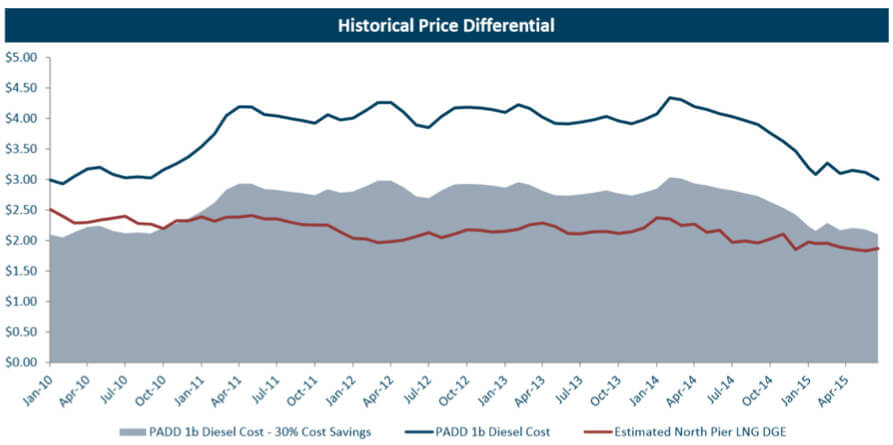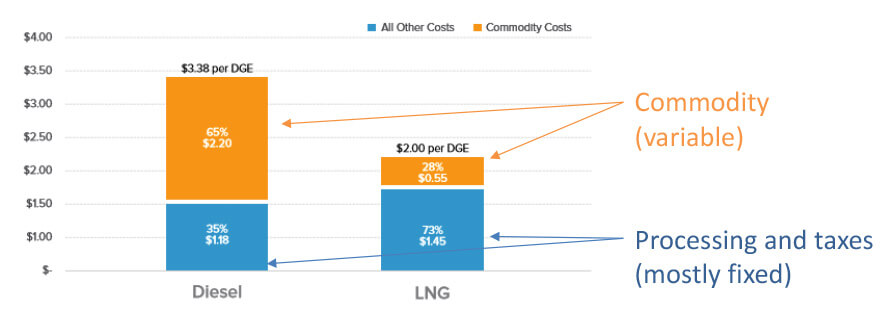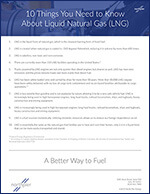Liquid Natural Gas
LNG is made from natural gas. The same gas used to heat your home in the winter. When natural gas cooled to -263 degrees Fahrenheit, it becomes a colorless, odorless, and non-corrosive liquid that is reduced in volume by more than 600 times; think about shrinking the volume of a beach ball to that of a ping pong ball [insert graphic] This change from gas to liquid – and its enormous reduction in volume – allows for much easier, more efficient transport. As a liquid, LNG can be pumped into fuel tanks of specially equipped trucks, trains and ships. LNG also allows gas to be moved efficiently in tank trucks, barges and ships.
North Pier LNG
North Pier Energy is the changing the way the region’s commercial trucking and construction grade equipment companies are fueling their bottom line. At North Pier we have created a model that saves not only on prices at the pump, but through predictable pricing and valuable tax savings. Contact our team if you think your company could benefit by investing in LNG—the modern fuel.
Cost Savings
Cost savings compared to diesel will be different in every region of the country, based upon local diesel and natural gas prices. At North Pier, we enjoy some of lowest gas prices in North America, with western Pennsylvania prices in the last several years varying between 50 and 90% of the Henry Hub index on the US Gulf Coast. And it’s getting cheaper.
IHS Energy recently projected that new gas production in our region through 2025 will exceed new gas demand by over 16 billion cubic feet of gas per day. With so much new supply, gas prices are expected to remain very low for years to come.
Taking into account historic diesel and natural gas prices in our region, LNG consistently provided an opportunity for more than 30% savings compared to diesel. The evidence is clear when you compares prices of one gallon of highway diesel in our region to one diesel gallon equivalent (DGE) of LNG.

For a company fueling commercial and construction grade vehicle fleets these savings add up. Monthly savings were estimated for January 2013 to August 2015 for a company using 1000 gallons of diesel fuel every month. In those 32 months, the company would have saved money every month, an average of $1,247 per month, and a total of $39,916. The estimates included delivery of LNG to a location in the Cleveland-Pittsburgh-Buffalo region.
Tax Savings
When you factor in savings in the form of federal tax credits, if the LNG is used for highway uses, the numbers continue to grow. In July 2015, Congress extended a $0.50 per gallon alternative fuel excise tax credit, which could reduce the company’s federal tax bill by up to $16,000 for the example above. Add to this a potential 30% alternative fuel infrastructure tax credit, and the tax credits could approach $30,000.
Reduced Volatility
LNG also reduces fuel price volatility for companies. As fuel prices increases, it is common to see trucking and distribution companies add “fuel surcharges” to their bills. With LNG, much of the price volatility disappears. The US Energy Information Administration compared commodity savings using typical prices for road diesel and LNG in 2014. When you consider commodity price volatility it is evident that with LNG there are several layers of added value.

Your company could immediately notice $1.38 per gallons savings. While 65% of the diesel price is tied to the volatile price of crude oil, only 28% of LNG cost is tied to natural gas. A 10% increase in oil prices will increase diesel by 6 to 7%. Where a 10% change in natural gas moves the price of LNG by about 3%.
At North Pier we understand that a company’s bottom line is important. Making the shift to LNG can mean immediate cost savings, helping your bottom line grow, while reducing your carbon footprint.
Uses for LNG
Historically, the main use of LNG was to store and transport natural gas in places that do not have adequate local energy supplies. In dozens of cities across the United States and Canada, utility companies make and store LNG in the summer months when they have a surplus gas supply, effectively stockpiling the gas to be used on cold winter days when everyone needs gas to heat their homes
Today, LNG is increasingly being used in high horsepower engines and is quickly gaining popularity for its lower price point when compared with diesel fuel. It allows more energy to be stored onboard a vehicle in a smaller volume than other alternative fuels. It is also gaining popularity for reducing emissions: According to the US Department of Energy, using LNG to fuel vehicles reduces greenhouse gas emissions by 30%-40% and also saves vehicle maintenance costs.
LNG is an ideal fuel for:
- Long-haul trucks
- Railroad locomotives
- Ships and tug boats
- Heavy construction and mining equipment
- Industrial, forestry, and agriculture operations far away from pipelines
Facts on LNG
To get the facts on LNG and its uses download 10 Things you Need to Know about LNG by North Pier.
At North Pier we are always looking for new and innovative ways to partner with our neighbors and enhance the community we call home. If you have a partnership opportunity for us to consider, please click here (info capture) to tell us about it.


